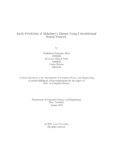| dc.contributor.advisor | Alam, Md. Ashraful | |
| dc.contributor.author | Abed, Mahjabeen Tamanna | |
| dc.contributor.author | Nabil, Shanewas Ahmed | |
| dc.contributor.author | Fatema, Umme | |
| dc.date.accessioned | 2020-02-19T05:54:10Z | |
| dc.date.available | 2020-02-19T05:54:10Z | |
| dc.date.copyright | 2019 | |
| dc.date.issued | 2019-08 | |
| dc.identifier.other | ID 17101268 | |
| dc.identifier.other | ID 12201087 | |
| dc.identifier.other | ID 16101330 | |
| dc.identifier.uri | http://hdl.handle.net/10361/13782 | |
| dc.description | This thesis is submitted in partial fulfillment of the requirements for the degree of Bachelor of Science in Computer Science, 2019. | en_US |
| dc.description | Cataloged from PDF version of thesis. | |
| dc.description | Includes bibliographical references (pages 33-38). | |
| dc.description.abstract | Neuroimaging can be a prospective instrument for the diagnosis of Mild Cognitive
Impairment (MCI) along with its more severe stage, Alzheimer's disease (AD). High-
dimensional classi cation methods have been commonly used to explore Magnetic
Resonance Imaging (MRI) for automatic classi cation of neurodegenerative diseases
like AD and MCI. Early AD or MCI can be diagnosed through proper examination of
several brain biomarkers such as Cerebrospinal Fluid (CSF), Media Temporal Lobe
atrophy (MTL) and so on. Abnormal concentrations of the mentioned biomarkers on
MRI images can be a potential sign of AD or MCI. In the recent times, several high-
dimensional classi cation techniques have been suggested to discriminate between
AD and MCI on the basis of T1-weighted MRI of patients. These techniques have
been implemented mostly from scratch, making it really di cult to achieve any
meaningful result within a short span of time. Therefore, classi cation of AD is
usually a very daunting and time consuming task. In our study, we trained high
dimensional Deep Neural Network (DNN) models with transfer learning in order to
achieve meaningful results very quickly. We have used three di erent DNN models
for our study: VGG19, Inception v3 and ResNet50 to classify between AD, MCI and
Cognitively Normal (CN) patients. Firstly, we implemented some pre-processing
steps on the images and divided them into training, testing and validation sets.
Secondly, we initialized these DNN models with the weights from pre-existing models
trained on the imagenet dataset. Finally, we trained and evaluated all the DNN
models. After relatively short amount of trainings (15 epochs), we achieved an
approximate of 90% accuracy with VGG19, 85% accuracy with Inception v3 and
70% with ResNet50. Thus, we achieved excellent classi cation accuracy in a very
short time with our research. | en_US |
| dc.description.statementofresponsibility | Mahjabeen Tamanna Abed | |
| dc.description.statementofresponsibility | Shanewas Ahmed Nabil | |
| dc.description.statementofresponsibility | Umme Fatema | |
| dc.format.extent | 38 pages | |
| dc.language.iso | en | en_US |
| dc.publisher | Brac University | en_US |
| dc.rights | Brac University theses are protected by copyright. They may be viewed from this source for any purpose, but reproduction or distribution in any format is prohibited without written permission. | |
| dc.subject | Alzheimer's Disease(AD) | en_US |
| dc.subject | VGG19 | en_US |
| dc.subject | Residual Network(ResNet) | en_US |
| dc.subject | Convolutinal Neural Network(CNN) | en_US |
| dc.subject | Transfer learning | en_US |
| dc.subject | Mild Cognitive Impairment(MCI) | en_US |
| dc.subject | Magnetic Resonance Imaging(MRI) | en_US |
| dc.subject.lcsh | Computer networks | |
| dc.title | Early prediction of Alzheimer's disease using convolutional neural network | en_US |
| dc.type | Thesis | en_US |
| dc.contributor.department | Department of Computer Science and Engineering, Brac University | |
| dc.description.degree | B. Computer Science | |

